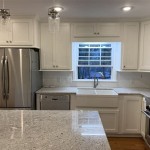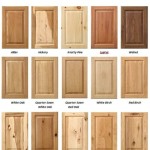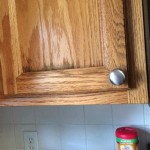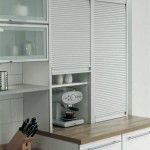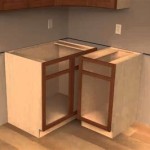New England Kitchen Cabinets: A Tradition of Craftsmanship and Style
New England kitchen cabinets represent more than just storage solutions; they embody a legacy of skilled craftsmanship, enduring materials, and timeless aesthetic appeal. For generations, the region has been renowned for its dedication to quality and attention to detail, resulting in cabinetry that often becomes a focal point within the home. Understanding the characteristics, materials, and design principles associated with New England kitchen cabinets provides valuable insight for homeowners seeking to create a kitchen that is both functional and aesthetically pleasing.
The history of cabinet making in New England is deeply intertwined with the region's access to high-quality lumber and a strong tradition of woodworking. Early settlers utilized readily available hardwoods like maple, cherry, and oak to construct durable and practical furniture, including kitchen cabinets. Over time, these initial utilitarian designs evolved, incorporating stylistic elements influenced by European trends and the growing affluence of the area. The emphasis, however, remained consistently on quality construction and lasting materials.
Key Characteristics of New England Kitchen Cabinets
Several defining characteristics distinguish New England kitchen cabinets from those produced in other regions or in mass-manufacturing settings. These features often reflect a commitment to traditional techniques and a preference for understated elegance.
One notable feature is the use of solid wood construction. While modern cabinet manufacturing often relies on particleboard or MDF (Medium-Density Fiberboard) for cost-effectiveness, New England cabinets typically feature solid wood frames, doors, and drawer fronts. This enhances the cabinets' structural integrity, extending their lifespan significantly. The use of solid wood also contributes to the unique grain patterns and natural variations that lend character to each piece.
Another defining characteristic is the focus on detailed joinery. Instead of relying solely on screws or adhesives, cabinet makers in New England often employ traditional joinery techniques such as dovetail joints, mortise-and-tenon joints, and tongue-and-groove construction. These methods create incredibly strong and durable connections, ensuring that the cabinets can withstand years of use without weakening or separating. This attention to detail is not only functional but also adds a subtle visual appeal, showcasing the skill of the craftsman.
Finally, the finish of New England kitchen cabinets is often characterized by its subtle elegance. While trends in cabinet finishes may vary over time, the preference in New England leans towards classic, understated options. Painted finishes, particularly in shades of white, cream, grey, or muted blues and greens, are popular choices. Stained finishes that highlight the natural grain of the wood are also common. The finishes are typically applied meticulously, ensuring a smooth and even surface that is both durable and aesthetically pleasing. Distressing techniques, such as antiquing or glazing, are sometimes employed to create a sense of age and character, reflecting the region's rich history.
Materials Commonly Used in New England Kitchen Cabinets
The selection of materials is paramount in determining the quality and longevity of kitchen cabinets. New England cabinet makers historically have favored locally sourced hardwoods, prized for their strength, beauty, and workability. Understanding the properties of these different wood species is essential for making informed decisions when choosing cabinetry.
Maple is a widely used hardwood in New England cabinet making, appreciated for its tight grain, smooth texture, and durability. It accepts paint and stain finishes well, making it a versatile choice for various kitchen styles. Maple is also relatively affordable compared to some other hardwoods, making it a popular option for homeowners seeking quality without exceeding their budget.
Cherry is another highly valued hardwood, known for its rich color, distinctive grain patterns, and ability to darken and develop a lustrous patina over time. Cherry cabinets add a touch of elegance and warmth to any kitchen. While typically more expensive than maple, the beauty and durability of cherry make it a worthwhile investment for many homeowners. The natural variations in cherry wood contribute to the unique character of each cabinet.
Oak, particularly red oak, has traditionally been a staple in New England cabinet making. Known for its strength, prominent grain pattern, and resistance to dents and scratches, oak is a practical choice for high-traffic kitchens. Oak cabinets can be stained in various colors, allowing homeowners to customize the look to their preferences. While oak's grain pattern can be more pronounced than maple or cherry, it adds a rustic charm that resonates with many New England homeowners.
In addition to these hardwoods, some cabinet makers may also incorporate softwoods like pine or poplar, particularly for cabinet interiors or secondary components. While not as durable as hardwoods, these softwoods are often more cost-effective and can be painted to match the exterior finish. It's important to inquire about the specific materials used in the construction of the cabinets to ensure that they meet the desired standards of quality and durability.
Design Principles Inspired by New England Style
New England kitchen design reflects a blend of practicality, comfort, and timeless elegance. These design principles are often manifested in the style and layout of the cabinetry, creating a welcoming and functional space.
One prominent design principle is the emphasis on functionality. New England kitchens are typically designed with the needs of the cook in mind, prioritizing efficiency and ease of use. Cabinet layouts are carefully planned to optimize workflow, with strategically placed storage solutions for cookware, utensils, and food items. Features like pull-out shelves, drawer dividers, and spice racks are commonly incorporated to maximize storage space and organization.
Another key principle is the preference for a classic, understated aesthetic. While modern trends may come and go, New England kitchen cabinets often feature simple, clean lines and traditional door styles like Shaker, raised panel, or beadboard. Ornate details are typically minimized, allowing the quality of the materials and craftsmanship to take center stage. This emphasis on timeless design ensures that the cabinets will remain stylish and relevant for years to come.
Finally, New England kitchens often incorporate elements that reflect the region's history and natural surroundings. Colors are often inspired by the landscape, with shades of white, cream, grey, blue, and green dominating the palette. Natural materials like wood, stone, and metal are used extensively, creating a warm and inviting atmosphere. Architectural details like exposed beams, wainscoting, and farmhouse sinks are also common, adding character and charm to the space. The goal is to create a kitchen that feels both comfortable and connected to its surroundings.
The hardware chosen for New England kitchen cabinets also plays a significant role in achieving the desired aesthetic. Classic styles such as knobs, pulls, and latches are typically favored, often crafted from materials like brushed nickel, oil-rubbed bronze, or antique brass. These hardware elements add a touch of elegance and functionality, complementing the overall design of the cabinets.
Lighting is another crucial element in New England kitchen design. Natural light is maximized whenever possible, with large windows and skylights allowing sunlight to flood the space. Under-cabinet lighting is often used to illuminate countertops and work areas, while pendant lights or chandeliers provide ambient lighting. The combination of natural and artificial light creates a welcoming and functional environment.
Ultimately, New England kitchen cabinets are more than just storage; they are an integral part of a larger design philosophy that values craftsmanship, durability, and timeless elegance. By understanding the key characteristics, materials, and design principles associated with these cabinets, homeowners can create a kitchen that reflects their personal style and honors the region's rich heritage.
The durability of New England kitchen cabinets extends beyond just the materials used. The meticulous construction techniques employed by skilled craftsmen contribute significantly to their longevity. Proper installation is also critical to ensure that the cabinets function optimally and withstand the rigors of daily use. Hiring experienced professionals to install the cabinets is a worthwhile investment that will protect the integrity of the cabinetry and ensure its long-term performance.
Maintaining New England kitchen cabinets is relatively straightforward, but regular cleaning and care are essential to preserve their beauty and functionality. Dusting the cabinets regularly with a soft cloth will prevent dirt and grime from accumulating. Occasional cleaning with a mild soap and water solution will remove any stubborn stains or spills. Avoid using harsh chemicals or abrasive cleaners, as these can damage the finish. Periodic waxing or polishing may also be recommended to protect the finish and enhance its luster.

Galleries New England Home

Galleries New England Home

Get Ready For Summer 2024 With New Cabinets England Kitchen Bath

Galleries New England Home

The Secret Recipe For A True English Kitchen Heather Hungeling Design

Karen Swanson Design A Historic New England Kitchen With Fresh British Style
Special Focus New England Kitchen Design 2024 Home

64 Kitchen Cabinet Design Ideas 2024 Unique Styles

Creating A Casual New England Style Kitchen Wherever You Live

Classic White New England Kitchen Scituate Ma Norfolk Bath
Related Posts


